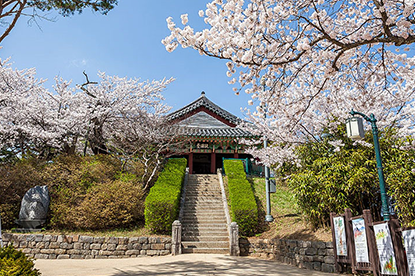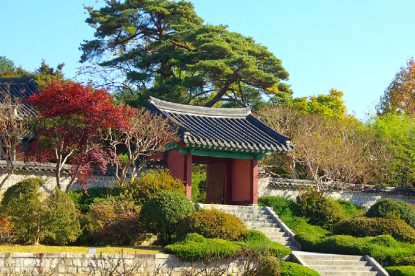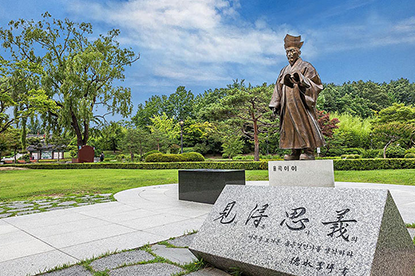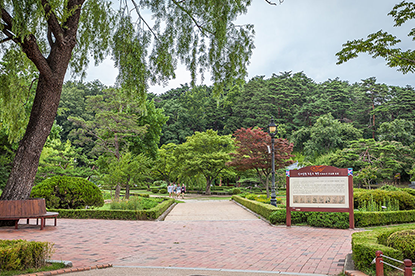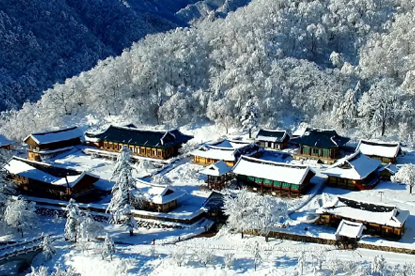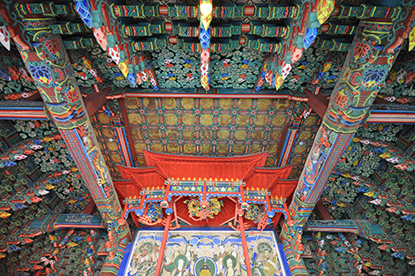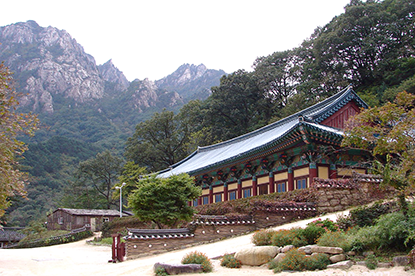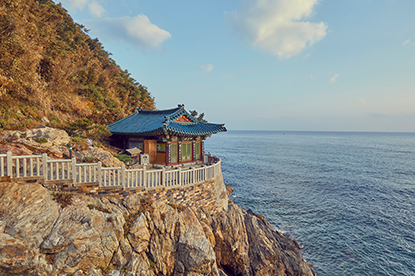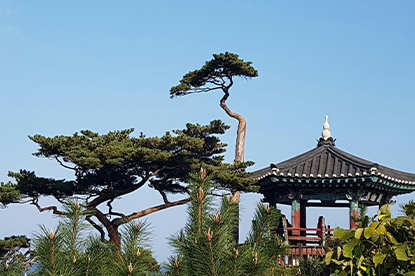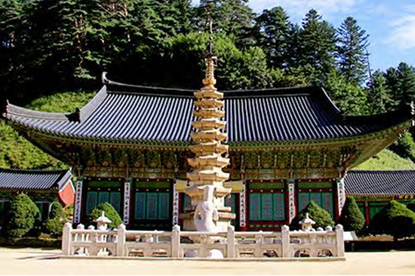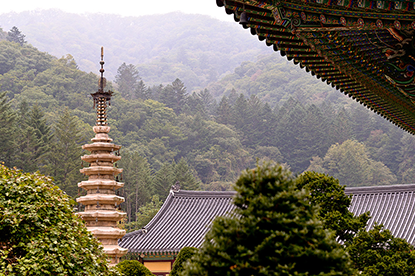Korean Heritage Passport Tour
- Incheon International Airport PR Center (Traveler Center)
- Gaya Culture Route
- Gwandong Pungryu Era Route
- Baekje Antiquity Route
- Korean Temple Monasteries (Sansa) Route
- Korean Confucian Academy Route
- Prehistoric Landscape Route
- Mythic Landscape Route
- Folk Music Route
- Royalty Route
- Golden Era Route
Gangneung, Sokcho, Yangyang, Pyeongchang – the jewel of Korean real landscape painting
Gangwon-do, home to the Eight Scenic Views of the Gwandong Region, is the cradle of Korean real landscape painting, which was often inspired by the beautiful natural landscapes of Korea, thanks to the splendid blend of the Baekdudaegan mountain range and the East Sea. Since ancient times, countless poets and travelers headed east to Gangwon-do, and writers spent time composing songs and poems praising the landscape, scenery, old history, and culture of Gangwon-do.
The Gwandong Pungryu Era Route is a great way to immerse yourself in the Eight Scenic Views of the Gwandong Region, which was perhaps best described in the Gwandongbyeolgok song written by Jeong Cheol (pen name: Songgang), a master lyricist during the Joseon Dynasty period, as well as traditional architecture built using the Daemokjang (traditional wooden architecture) techniques, which has been designated as one of the Masterpieces of the Oral and Intangible Heritage of Humanity by UNESCO.

Gangneung, Sokcho, Yangyang, and Pyeongchang are all easy to reach by car or public transportation. Your best option for getting to Gangneung is to take a bus from the Express Bus Terminal. Gyeongpodae, Seongyojang, and Ojukheon are located close to one another in Gangneung, which means you can visit them all in one day. Meanwhile, Yangyang, Sokcho, and Pyeongchang have convenient train or express bus services. But they are located quite far away from each other, meaning it would be difficult to visit more than one city a day. Naksansa Temple is located near the sea, whereas Sinheungsa Temple and Woljeongsa Temple are located at Seoraksan Mountain and Odaesan National Park. We recommend you spend at least one day at each of these temples to escape from city life and spend some time in nature.
Flavors of Gangneung, Yangyang, Sokcho, and Pyeongchang might just leave a lasting memory
-
Squid Sundae (squid sausage)
Glutinous rice and various minced vegetables are stuffed inside the body of a squid.
-
Sanchae Jeongsik (course meal with wild vegetables)
Hanjeongsik (Korean-style full-course meal) featuring various wild vegetables from the mountains of Gangwon-do.
-
Chodang Sundubu (soft tofu soup)
A tofu dish made using seawater as the coagulant.
Korean Heritage festivals in Gangneung, Yangyang, Sokcho, and Pyeongchang
-
Gangneung Danoje Festival
The Namdaecheon Danojang is the first event of its kind in the history of the Gangneung Danoje Festival to incorporate installation art, and it is designed so that people can enter in full compliance with quarantine guidelines so that they can make their wishes in peace during the Dano period. In addition, various video and photo content of Gangneung Danoje Festival will be available in the form of media art at the Myeongju Art Madang to capture the extraordinary traditional beauty of the Danoje Festival using contemporary art.
For more details, please check the festival’s official website below.
Websitewww..danojefestival.or.kr
-
Gangneung International Film Festival
Gangneung has long been known as the city of literature and art. The ‘Film and Literature” section showcases the unique colors of the Gangneung International Film Festival, and consists of various sub-sections, including special exhibitions and artist exhibitions. It also explains the fusion between the two art genres, film and literature, which started when the new genre of cinema was born.
For more details, please check the festival’s official website below.
Websitewww.giff.kr
-
Yangyang Cultural Festival
n the 10th year of King Mokjong's reign (Goryeo Dynasty, 1007 CE), starting with the city of Yangyang there began an event called the Yangyang Seonghwangje to pray for the safety and prosperity of Goryeo and its people. Today, the Yangyang Culture Festival is a local culture festival that gets under way on the banks of Namdaecheon River in Yangyang right around Dano day each year.
For more details, please contact the festival organizers by phone.
Inquiries033-670-2795
-
Pyeongchang Odaesan Cultural Festival
Since 2004, the Pyeongchang Odaesan Cultural Festival at Woljeongsa Temple has been a traditional culture festival carrying on the beautiful legacy, tradition, history, and culture of Odaesan Mountain.
For more details, please check the festival’s official website below.
Website http://woljeongsa.org/bbs/content.php?co_id=10303010
-
Pyeongchang Daegwallyeong Snow Festival
Daegwallyeong is often noted as the “Mecca” of winter in Korea, and the Pyeongchang Daegwallyeong Snow Festival is a winter festival that promotes the magnificent winter environment of Daegwallyeong in January every year.
For more details, please check the festival’s official website below.
Website http://www.snowfestival.net/
-
Sokcho Seorak Cultural Festival
The Sokcho Seorak Cultural Festival is a historic local festival featuring Seoraksosa, an event inspired by an ancient ritual ceremony. The Festival showcases the beautiful scenery and culture of Sokcho nearby the Seorak area with pristine mountaintops, clean ocean, mirror-like lakes, and generous locals.
For more details, please check the festival’s official website below.
Website http://sokchofestival.or.kr/srcf
- Gyeongpodae Pavilion, Gangneung
- Seongyojang House, Gangneung
- Ojukheon House, Gangneung
- Sinheungsa Temple, Sokcho
- Naksansa Temple, Yangyang
- Woljeongsa Temple, Pyeongchang
Gyeongpodae Pavilion in Gangneung, one of Gangneung’s most scenic spots
-
Address
365, Gyeongpo-ro, Gangneung-si, Gangwon-do
-
Inquiries
033-640-4471
-
Stamp
At the entrance of Gyeongpodae
-
Opening hours
09:00 - 18:00, daily (open year-round)
-
Directions
ake a bus bound for the Gangneung Bus Terminal at Dongseoul Bus Terminal → Get off at Gangneung Express Bus Terminal and walk to a regular bus stop → Take bus no. 202 at Gangneung Intercity/Express Bus Terminal stop → Get off at Gyeongpodae Pavilion/Chamsori Museum
Throughout Korean history, Gyeongpodae Pavilion appears in countless poems, including “Gyeongpodae” and “Gangngeunpalyeong” by Kim Geuk-gi (middle of the Goryeo Dynasty period) as well as “Gwandongpalgyeong” by Ahn Chuk (late Goryeo Dynasty period) and “Gwandongpalgyeong” by Jeong Cheol (pen name: Songgang; Joseon Dynasty period). It was particularly popular among poets and travelers from across the country as a place to enjoy the natural scenery and study. Gyeongpodae Pavilion is a large pavilion and a great example of architecture during the late Joseon Dynasty period. It has a gambrel roof, 48 pillars, five sections at the front, and five sections to the side. Inside the pavilion, the side facing the lake is raised one more level to make an additional floor, and then, this second floor is raised another level to the left and right to create a third floor. This design, which is rarely seen in other pavilions, was chosen to give the viewer the added benefit of enjoying the magnificent scenery of Gyeongpoho Lake from a higher vantage point. The pavilion has two signboards saying, “Gyeongpodae” - the signboard in the Seal font was written by Yi Ik-hoe. Inside the pavilion are several pieces of writings by master scholars, poets, and travelers throughout Korean history, including “Gyeongpodaebu” written by Yi I (pen name: Yulgok) when he was only ten years old, “Eojesi” composed by King Sukjong himself, and “Sangryangmun” by Cho Ha-mang, which is one of the reasons why Gyeongpodae Pavilion holds such cultural significance in Korean history. The oldest records of Gyeongpodae Pavilion can be found in “Palyeong” by Kim Geuk-gi, an administrator during the reign of King Myeongjong of Goryeo. The pavilion was demolished in 1326 (13th year of King Chungsuk). It was later rebuilt in the old site of Inwolsa Temple, then relocated to its current location in 1508 (3rd year of King Jungjong) by the Governor of Gangneung, Han Geup. Since its relocation, the pavilion has been repaired and restored multiple times to keep it in good condition. In recognition of its substantial historical and academic value, Gyeongpodae Pavilion was designated as a registered Korean Heritage in December 2019.

Provided by the Tourism Department at Gangneung City Hall
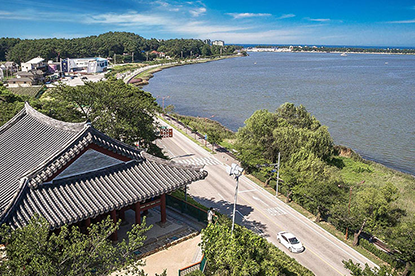
Provided by the Tourism Department at Gangneung City Hall
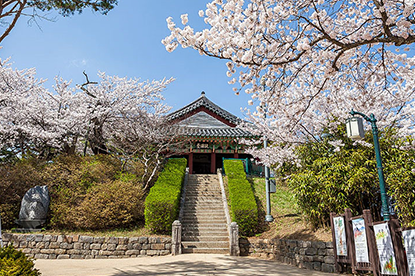
Provided by the Tourism Department at Gangneung City Hall

In the early days, the people of Gangneung called the eight scenic spots visible from Gyeongpodae Pavilion the “Gyeongpo Palgyeong.” The Gyeongpo Palgyeong includes the sunrise at Nokdujeong, bright moonlight in Jukdo, moonrise and evening rain in Hongjangam, lights of fishing boats off the coast of Gangmun, and smoke from ovens cooking dinner at Chodang Village. Try sitting inside Gyeongpodae Pavilion, enjoy the old pine trees and oak trees lining Gyeongpoho Lake, and immerse yourself in the unique style and elegance of Korea’s Gwandong region.









